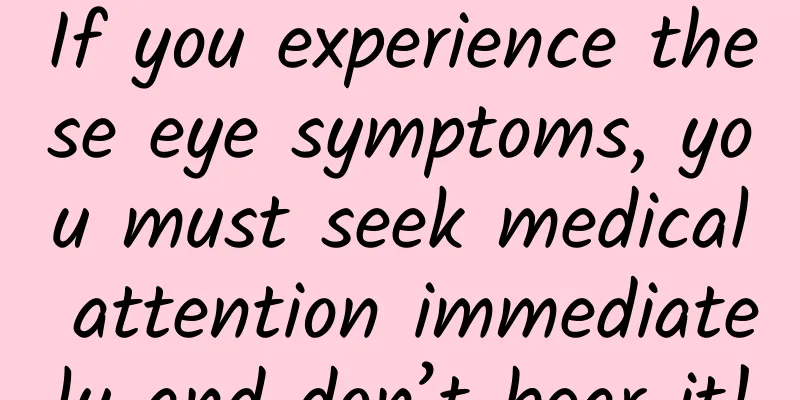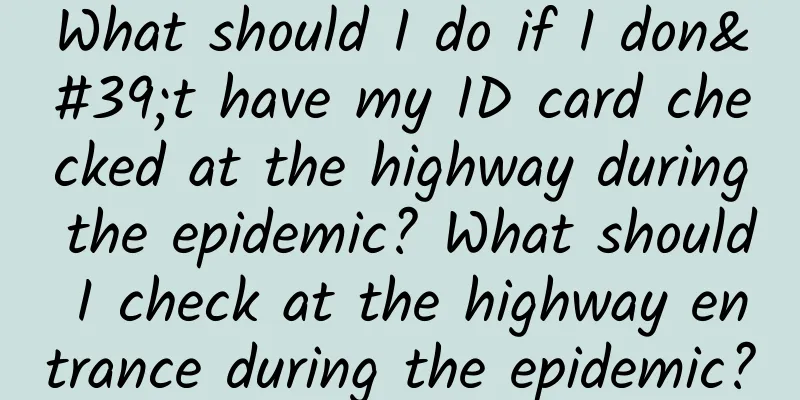If you experience these eye symptoms, you must seek medical attention immediately and don’t bear it!

|
During our outpatient visits, we often see patients like these: "Doctor, please take a look at my eyes. There is bleeding in my eyes. This is terrible. Am I going blind?" The patient rushed to the hospital, very nervous and panicked, but the doctor took one look and was very calm. He simply checked the patient and sent him home without prescribing any medicine. The patient didn't understand why the doctor was so slow in such a "critical" situation when his eyes were bleeding. Subconjunctival hemorrhage Image source: Reference [3] In fact, this is not called retinal hemorrhage, it is called subconjunctival hemorrhage, which is bleeding caused by rupture of conjunctival capillaries. Although it looks scary, it has no effect on visual function and does not require any drug treatment or emergency treatment. This is the disease that patients are very anxious about in ophthalmology outpatient clinics and emergency departments, but doctors are the least anxious about. So in daily life, what kind of eye problems require medical attention as soon as possible, and what kind of eye problems can be treated by observation? Let's talk about them in detail today~ Sudden vision loss Need medical attention as soon as possible Vision is the most important indicator for assessing eye function. Ophthalmologists are most sensitive to symptoms of decreased vision, especially obvious and noticeable decreased vision in one or both eyes in a short period of time. This decrease in vision is compared with the previous stable state. Sudden decrease in vision often indicates organic lesions in the eye. Sudden vision loss includes painless vision loss and vision loss accompanied by obvious pain. 1. Sudden painless vision loss ① Central retinal artery occlusion. The central retinal artery is the first branch of the ophthalmic artery and supplies blood to the inner layer of the retina. Interruption of retinal blood perfusion can lead to ischemic retinal damage, which in turn causes acute and severe vision loss in one eye. Patients usually do not feel any pain or other discomfort. The incidence rate is about 1-10 cases per 100,000. Although the incidence rate is very low, if it is not treated in time, it will lead to irreversible visual function damage. This is one of the only emergencies in ophthalmology. Central retinal artery occlusion Image source: Reference [4] ②Vitreous hemorrhage. Vitreous hemorrhage refers to the sudden loss of vision caused by the rupture and bleeding of blood vessels in the eye tissue. The blood enters the vitreous cavity and the bleeding mostly comes from the retinal blood vessels. Typical symptoms include painless floaters and sometimes flashes of light. The degree of vision loss is proportional to the amount of blood accumulated in the vitreous. It is more common in trauma, retinal tears, and poor blood sugar control in diabetic patients. ③ Retinal vein occlusion. Retinal vein occlusion can cause true "retinal hemorrhage". It usually presents as painless blurred vision in one eye. Unlike the visual loss caused by central retinal artery occlusion, it usually has a subacute onset, while the typical visual loss caused by central retinal artery occlusion is sudden. Retinal vein occlusion Image source reference [5] Retinal vein occlusion Image source: Reference [6] ④ Retinal detachment. The patient will describe the sudden appearance of new floaters or black spots in the field of vision, often accompanied by flashes of light, without any pain. In the early stages of the disease, retinal detachment manifests as a sense of "black shadow" blocking the view in front of one eye. The position of the "black shadow" is relatively fixed, and the symptoms of decreased vision are not prominent. Once retinal detachment involves the macular area, vision will be severely impaired. Rhegmatogenous retinal detachment is the most common type. Risk factors include myopia, previous cataract surgery history, ocular trauma, lattice retinal degeneration, family history of retinal detachment, etc. Retinal detachment Image source: Reference [7] Rhegmatogenous retinal detachment Image source: Reference [8] ⑤ Ischemic optic neuropathy refers to ischemic damage to the optic nerve due to interrupted blood supply, resulting in sudden, painless, severe vision loss. Ischemia develops quickly (minutes, hours to days), and some patients experience vision loss when they wake up in the early morning, which is generally believed to be related to nocturnal hypotension. 2. Vision loss with pain ① Acute attack of acute angle-closure glaucoma. This is also one of the most urgent emergencies in ophthalmology. It manifests as sudden vision loss, rainbow-like stripes or halos when looking at lights, called iridescence, accompanied by obvious eye pain. In severe cases, there are symptoms such as severe headaches, repeated nausea, and vomiting. Most of the symptoms occur in the evening or at night. Many people go to neurology and gastroenterology departments for treatment due to severe headaches, nausea, and vomiting, thus delaying diagnosis and treatment. It is more common in people with a family history of angle-closure glaucoma, those aged >60 years, women, hyperopia (farsightedness), and long-term use of certain glaucoma-inducing drugs, etc. Therefore, for headaches, nausea, vomiting, redness of one eye, and decreased vision that occur at night and are not related to diet, one should be highly alert to the possibility of acute angle-closure glaucoma. ② Optic neuritis. Optic neuritis is most common in adults aged 20 to 40. The main symptom is decreased vision, which is often most obvious within a few days. The degree of decreased vision varies, and can manifest as central or paracentral dark spots or even complete blindness. Most patients are accompanied by mild eye pain, which is often aggravated by eye movement. Note: The above are relatively common eye diseases that present as acute or subacute painless vision loss. Among them, central retinal artery occlusion has a very poor prognosis, and 92% of patients end up with vision of only a few fingers or worse. Without intervention, more than 80% of patients will eventually become monocularly blind, so its treatment needs to race against time. Most patients cannot tell which disease they have, so it is recommended that they seek medical attention as soon as possible if there is a sudden and obvious decrease in vision. Here we would like to remind everyone that a considerable number of elderly people think they have presbyopia when their vision deteriorates ("presbyopia" is a common functional eye problem among people over 50 years old), but "presbyopia" only manifests as a decrease in near vision, while distance vision is basically unaffected. The above-mentioned diseases all manifest as a decrease in vision throughout the entire process, and "presbyopia" will not appear suddenly. Copyright images in the gallery, reprinting and using may cause copyright disputes Because our two eyes' fields of vision partially overlap, it is sometimes difficult to detect a decrease in vision in one eye. Here is a simple method to help you make the judgment. Cover one eye with your hand and use only the other eye to look at a distance of 6 meters away. Carefully compare the clarity of what you see with both eyes. If there was no noticeable difference in vision between the two eyes before, this simple method can easily detect a decrease in vision in one eye. Eye injuries See a doctor as soon as possible Eye injuries are the most common type of disease seen in ophthalmic emergencies. As people's awareness of self-protection increases, most people will go to the ophthalmology department for examination after eye injuries. However, some people still do not pay enough attention to eye injuries and do not seek medical treatment in time, which eventually leads to delayed treatment and irreversible vision damage. Eye injuries include mechanical eye injuries and chemical eye injuries. 1. Mechanical eye injury Common causes of injury include accidental injuries while drilling, welding, hammering, and nailing metal; being hit by objects such as fingernails, scissors, sticks, or branches of trees or other vegetation; setting off fireworks and using other explosives; sports-related blunt trauma from balls and sports equipment or accidental contact (such as an elbow to the eye); and other blunt mechanisms, such as being hit with a fist or other object, air bag deployment in a motor vehicle crash, falls, or rebounding from a bungee cord. After a mechanical eye injury, you should first check the eyelids and skin around the eyes for damage and bleeding. Because the skin around the eyes has a rich blood supply, it is easy to bleed profusely after the skin is torn. Don't panic at this time. Use a relatively clean towel or fabric to press the wound hard to stop the bleeding. Never use "local methods" or "folk remedies" to sprinkle various "medicines" or "powders" into the skin wound. Secondly, check the vision of the injured eye according to the above method. If there is a significant decrease in vision, seek medical attention in time. 2. Chemical eye injury Common ones include household acidic and alkaline detergents, food desiccants containing lime, alcohol, cosmetics, hot oil, pesticides, corrosive drugs for skin, etc. Chemical burns of the eye can cause decreased vision, moderate to severe eye pain, blepharospasm (inability to open the eye), conjunctival redness, and photophobia. In severe cases (such as exposure to strong alkalis), ischemia of the conjunctival and scleral blood vessels may cause the eyes to turn white, which may not seem serious, but is actually the chemical injury with the worst prognosis. The severity of the burn depends on the injuring chemical, the duration of exposure, and the depth of penetration. Coagulative necrosis caused by acid burns may cause vision-threatening corneal ulcers and scarring, but is often self-limited. Alkali can saponify phospholipid membranes, leading to liquefied necrosis of the eye and rapid death of epithelial cells, causing alkaline damage to penetrate further into deep tissues, so alkali burns are usually more severe than acid burns. Once a chemical injury occurs, the first thing to do is to rinse with plenty of clean water as soon as possible. If you are at home, you can use clean drinking water or tap water to rinse your eyes for a long enough time. If you are outdoors, you can use bottled drinking water or relatively clean natural water sources such as rivers and lakes to rinse as soon as possible. Our principle of treatment is to rinse first and then seek medical treatment. Do not delay the flushing time because of the rush to see a doctor. When seeking medical treatment, it is best to bring the packaging, labels containing the names of chemical substances or photos containing relevant information so that the doctor can quickly determine the chemical composition. Eye injuries often occur in daily life, especially in children. Once an eye injury occurs, it often causes serious damage to the visual function. Therefore, prevention is more important than treatment for eye injuries. Finally, it is recommended that you always have a pair of simple goggles to avoid a large part of eye injuries. Take a test: My eyes felt uncomfortable, so I rubbed them hard for a few times and found a "big blister" on the surface of the white of my eye. It was terrible. Do I need to seek emergency medical attention in this case? Answer: No emergency medical attention is needed. This is conjunctival edema, which is common in children and is easy to occur after allergic conjunctivitis and vigorous rubbing of the eyes. Conjunctival edema can cause mild eye discomfort, does not affect vision, and is painless. Most of the time, it will be absorbed and disappear on its own after a few hours. References [1] Merck Manual of Diagnosis and Treatment [2]https://www.msdmanuals.cn/professional/eye-disorders/conjunctival-and-scleral-disorders/subconjunctival-hemorrhages. [3]https://www.msdmanuals.cn/professional/eye-disorders/retinal-disorders/central-retinal-artery-occlusion-and-branch-retinal-artery-occlusion. [4]https://www.msdmanuals.cn/professional/eye-disorders/retinal-disorders/central-retinal-vein-occlusion-and-branch-retinal-vein-occlusion. [5]https://www.retinamn.com/retinal-conditions/central-retinal-vein-occlusion. [6]https://rehmansiddiqui.com/understanding-retinal-detachment/ [7]https://www.retinamn.com/retinal-conditions/retinal-tears-detachments Author: Liu Gang, Chief Ophthalmologist, Qilu Hospital, Shandong University, Qingdao Branch Review丨Jin Xiuming, Deputy Director of the Ophthalmology Center, Zhejiang University Second Hospital |
<<: The most searched! This "pet" that is popular among children is very dangerous →
Recommend
How to prevent thrombosis in patients with PICC catheterization
At present, the development speed of my country&#...
How to prevent breast sagging after childbirth
For women, breasts are a unique symbol of a woman...
Does bayberry need to be soaked in salt water? How to make bayberry delicious when it is sour
Bayberry contains nutrients such as vitamin C, pr...
What causes brown menstrual blood?
If the menstrual blood is dark brown, then you ne...
What department should a woman go to for a full physical examination?
Physical examination is very important. People sh...
Is it normal for a woman to not have her period for a month?
The biggest difference between female friends and...
What causes acne in girls
I believe that girls hate having pimples on their...
37 weeks pregnant, belly feels heavy
When a pregnant woman is 37 weeks pregnant, she i...
Can women still get pregnant after menopause?
As we all know, women in their forties to fifties...
Precautions for patients with trigeminal neuralgia
Trigeminal neuralgia is a common neurological dis...
Young people should not take high blood pressure lightly and beware of the “invisible killer” - cerebral hemorrhage!
Nowadays, with the change of lifestyle, cerebral ...
26 Week Induction of Labor
If a woman wants to have an induced abortion at 2...
Pay attention to this symptom! It is likely to be herpes zoster
"Why won't this little rash on my waist ...
Will taking detoxifying beauty capsules affect menstruation?
Nowadays, for the sake of health, many people, ma...









